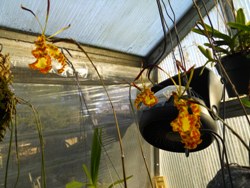Last weekend I attended the Orchid Society of Greater Kansas City’s exhibit at the KC Lawn and Garden Show. The OSGKC invited several regional societies and national orchid vendors to join our local group for this big event.
Attending a show like this is a great opportunity to learn from some of the best growers in the country. Here are three tips I learned about raising Phragmipediums. The first tip is from Russ Vernon of New Vision Orchids in Indiana and the last two are from Sandy Wells of Hilltop Orchids, also in Indiana.
1. To enhance the brightness of the red blossoms on a besseae phrag, keep the spiking plant cool – around 50 degrees.
2. For more vigorous and blooming phrags, add Epsom Salts once a month when watering: two tablespoons of Epsom Salts per one gallon of water.
3. Also, work a dolomite lime dressing into phrags’ growing medium every four months.
I received a comment on the last post about the damaged phal leaves. A member of the St. Augustine Orchid Society mentions using a regime that calls for Phyton. [Read about Tom Nassar’s suggestions in the SAOS newsletter.]

